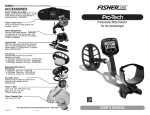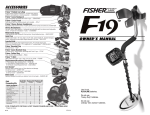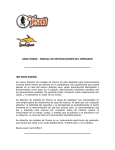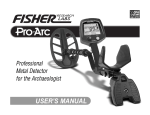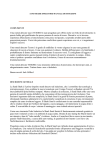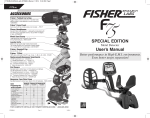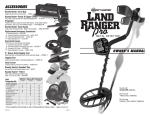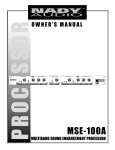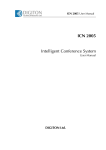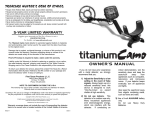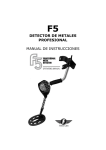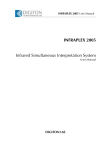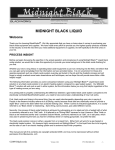Download USER`S MANUAL
Transcript
ProTechMANUAL_MPROTECH 1/8/15 5:31 PM Page 3 Professional Metal Detector For the Archaeologist USER’S MANUAL ProTechMANUAL_MPROTECH 1/8/15 5:31 PM Page 4 PRO-TECH Comprehensive Operating Manual & Guide to Metal Detecting If you do not have prior experience with a metal detector, we strongly recommend that you: 1) Adjust the Gain to a low setting in the event of false signals. Always begin use at a reduced Gain level; increase Gain only after you have become familiar with the detector. 2) Do not use indoors. This detector is for outdoor use only. Many household appliances emit electromagnetic energy, which can interfere with the detector. If conducting an indoor demonstration, turn the Gain down and keep the searchcoil away from appliances such as computers, televisions and microwave ovens. If your detector beeps erratically, turn off appliances and lights. Also keep the searchcoil away from objects containing metal, such as floors and walls. 3) Use a 9-volt ALKALINE battery only. Do not use Heavy Duty Batteries. 2 ProTechMANUAL_MPROTECH 1/8/15 5:32 PM Page 7 Comprehensive Operating Manual & Guide to Metal Detecting PRO-TECH Table of Contents Introduction . . . . . . . . . . . . . . . . . . . . . . . . . . . . . . . . . . . . . . . . . . . . . . . . . . . . . . . .4 Terminology . . . . . . . . . . . . . . . . . . . . . . . . . . . . . . . . . . . . . . . . . . . . . . . . . . . . . . . .5 Assembly . . . . . . . . . . . . . . . . . . . . . . . . . . . . . . . . . . . . . . . . . . . . . . . . . . . . . . . .6-7 Batteries . . . . . . . . . . . . . . . . . . . . . . . . . . . . . . . . . . . . . . . . . . . . . . . . . . . . . . . . . . .8 Quick-Start Demo . . . . . . . . . . . . . . . . . . . . . . . . . . . . . . . . . . . . . . . . . . . . . . . . .9-10 Headphones . . . . . . . . . . . . . . . . . . . . . . . . . . . . . . . . . . . . . . . . . . . . . . . . . . . . . .10 Basics Of Metal Detecting . . . . . . . . . . . . . . . . . . . . . . . . . . . . . . . . . . . . . . . . .11-12 Ground Minerals . . . . . . . . . . . . . . . . . . . . . . . . . . . . . . . . . . . . . . . . . . . . . . . .11 Trash . . . . . . . . . . . . . . . . . . . . . . . . . . . . . . . . . . . . . . . . . . . . . . . . . . . . . . . . .12 Identifying Buried Objects . . . . . . . . . . . . . . . . . . . . . . . . . . . . . . . . . . . . . . . .12 Size and Depth of Buried Objects . . . . . . . . . . . . . . . . . . . . . . . . . . . . . . . . . .12 Electromagnetic Interference . . . . . . . . . . . . . . . . . . . . . . . . . . . . . . . . . . . . . .12 Operation and Controls . . . . . . . . . . . . . . . . . . . . . . . . . . . . . . . . . . . . . . . . . . . . . .13 Control Panel . . . . . . . . . . . . . . . . . . . . . . . . . . . . . . . . . . . . . . . . . . . . . . . . . . . . . .13 Control Knobs Off / On / Gain / Disc / All Metal / Threshold . . . . . . . . . . . . . . . . . . . . . . . . . .14 Touchpad Controls GG / Pinpoint . . . . . . . . . . . . . . . . . . . . . . . . . . . . . . . . . . . . . . . . . . . . . . . . . .15 + and - . . . . . . . . . . . . . . . . . . . . . . . . . . . . . . . . . . . . . . . . . . . . . . . . . . . . . . .15 Operating in All Metal Mode Ground Grab® (GG) Computerized Ground Balancing . . . . . . . . . . . . . . . . . . .16 Setting the Controls . . . . . . . . . . . . . . . . . . . . . . . . . . . . . . . . . . . . . . . . . . . . .16 Unwanted Noise . . . . . . . . . . . . . . . . . . . . . . . . . . . . . . . . . . . . . . . . . . . . . . . .16 Sweeping the Searchcoil . . . . . . . . . . . . . . . . . . . . . . . . . . . . . . . . . . . . . . . . .16 Reading the Display . . . . . . . . . . . . . . . . . . . . . . . . . . . . . . . . . . . . . . . . . . . . .17 Target Scale . . . . . . . . . . . . . . . . . . . . . . . . . . . . . . . . . . . . . . . . . . . . . . . . . . .17 Operating in Discrimination Mode Ground Grab® (GG) Computerized Ground Balancing . . . . . . . . . . . . . . . .17-18 Setting the Controls . . . . . . . . . . . . . . . . . . . . . . . . . . . . . . . . . . . . . . . . . . . . .18 Gain . . . . . . . . . . . . . . . . . . . . . . . . . . . . . . . . . . . . . . . . . . . . . . . . . . . . . . . . .18 Mode . . . . . . . . . . . . . . . . . . . . . . . . . . . . . . . . . . . . . . . . . . . . . . . . . . . . . . . . .18 Disc Level . . . . . . . . . . . . . . . . . . . . . . . . . . . . . . . . . . . . . . . . . . . . . . . . . . . . .18 Unwanted Noise . . . . . . . . . . . . . . . . . . . . . . . . . . . . . . . . . . . . . . . . . . . . . . . .18 Sweeping the Searchcoil . . . . . . . . . . . . . . . . . . . . . . . . . . . . . . . . . . . . . . . . .19 Using Pinpoint . . . . . . . . . . . . . . . . . . . . . . . . . . . . . . . . . . . . . . . . . . . . . . . . .19 Reading the Display . . . . . . . . . . . . . . . . . . . . . . . . . . . . . . . . . . . . . . . . . .19-21 Ground Balancing . . . . . . . . . . . . . . . . . . . . . . . . . . . . . . . . . . . . . . . . . . . .22-24 Ground Balancing Technical Info . . . . . . . . . . . . . . . . . . . . . . . . . . . . . . . . . . . . . . .25 Target Display & Audio . . . . . . . . . . . . . . . . . . . . . . . . . . . . . . . . . . . . . . . . . . . . . .26 Hot Rocks . . . . . . . . . . . . . . . . . . . . . . . . . . . . . . . . . . . . . . . . . . . . . . . . . . . . . . . .27 Electrical Interference (EMI) . . . . . . . . . . . . . . . . . . . . . . . . . . . . . . . . . . . . . . . .27-29 Search Techniques . . . . . . . . . . . . . . . . . . . . . . . . . . . . . . . . . . . . . . . . . . . . . . . . .30 Target Pinpointing . . . . . . . . . . . . . . . . . . . . . . . . . . . . . . . . . . . . . . . . . . . . . . . . . .31 Device Specifications . . . . . . . . . . . . . . . . . . . . . . . . . . . . . . . . . . . . . . . . . . . . . . .32 Warranty . . . . . . . . . . . . . . . . . . . . . . . . . . . . . . . . . . . . . . . . . . . . . . . . . . . . . . . . .33 Accessories . . . . . . . . . . . . . . . . . . . . . . . . . . . . . . . . . . . . . . . . . . . . . . . .Back Cover 3 ProTechMANUAL_MPROTECH 1/8/15 5:32 PM Page 8 PRO-TECH Comprehensive Operating Manual & Guide to Metal Detecting Introduction to the PRO-TECH The PRO-TECH is a professional grade metal detector, designed specifically for the Archaeological professional. It comes equipped with a carry case and everything you will need on the dig site. This manual has been written to help you get optimal use of your detector, so we hope you will read it thoroughly before your first outing and will also refer back to this manual from time to time to reinforce features and methods as you become more proficient in the field. The new PRO-TECH is unique among professional metal detectors for its combination of high sensitivity to small targets and its versatile function as an allpurpose metal detector. It is lightweight, very easy to use, and the single 9V batter will give up to 20 hours of continuous use. The controls and features are tailored to Archeology including a sophisticated ground balancing system, separate control over signal gain and threshold, and a unique discrimination control system. With an on-screen Ground Phase readout it is possible to notice extreme shifts in mineralization which could indicate a location where a fire destroyed a wooden structure. 4 ProTechMANUAL_MPROTECH 1/8/15 5:32 PM Page 11 Comprehensive Operating Manual & Guide to Metal Detecting PRO-TECH TERMINOLOGY The following terms are used throughout the manual, and are standard terminology in regard to professional metal detectors. Elimination Reference to a metal being "eliminated" means that the detector will not emit a tone, nor light up an indicator, when a specified object passes through the searchcoil's detection field. Discrimination When the detector emits different tones for different types of metals, and when the detector "eliminates" certain metals, we refer to this as the detector "discriminating" among different types of metals. Discrimination is an essential feature of professional metal detectors. Discrimination allows the user to ignore trash and other undesirable objects. Iron Iron is a common, low-grade metal that may be an undesirable target in certain metal detecting applications. Examples of undesirable iron objects are old cans, pipes, bolts and nails. In most Dig Site situations, you will want to recover all of the metal targets, including the iron. Ferrous Metals which are made of, or contain, iron. Pinpointing Pinpointing is the process of finding the exact location of a buried object. Longburied metals can appear to the eye exactly like the surrounding soil, and can therefore be very hard to isolate from the soil. V.C.O. Meaning "voltage controlled oscillator," the V.C.O. audio method causes both the audio pitch and the volume to rise as signal strength increases. V.C.O. improves the user's ability to interpret a target's size and depth. Very weak signals (for small or very deeply buried objects) have the faintest volume and the lowest pitch. Larger objects, and those closer to the searchcoil, will create a higher volume and higher pitch sound. Ground Balance Ground Balancing is the ability of the detector to ignore, or "see through" the earth's naturally occurring minerals, and only sound a tone when a metal object is detected. The PRO-TECH incorporates proprietary circuitry and programming to eliminate false signals from severe ground conditions. 5 ProTechMANUAL_MPROTECH 1/8/15 5:32 PM Page 12 PRO-TECH Nut Comprehensive Operating Manual & Guide to Metal Detecting ASSEMBLY Adjusting the Armrest The armrest may be moved forward or backward by removing the single screw and nut, and then repositioning the 2-piece armrest. Users with shorter arms may find the armrest more comfortable in the forward position. In order to move the armrest backward, the plastic plug must be removed from the aluminum tube. Armrest Strap Armrest Arm Strap Screw Battery Compartment (back side) Hand-grip The PRO-TECH comes with an armrest strap for users who prefer to swing the detector vigorously, in order to hold the detector securely against the arm. The detector can always be used without the strap, with no compromise to detector balance and stability under most conditions. S-Rod 1/4” Headphone H d h Jack Cable Plug Searchcoil Cable Velcro Strap Locking Collar Upper Stem Locking Collar Arm Strap Velcro Strap Searchcoil 6 ProTechMANUAL_MPROTECH 1/28/15 8:15 AM Page 15 Caution: Forcing in MIDDLE STEM with CAM LOCK raised may form a burr on Comprehensive Operating Manual & Guide to Metal Detecting ASSEMBLY ●1 ●2 ●3 PRO-TECH camlock. If this happens, remove burr with knife to allow insertion. Position S-Rod upright. Rotate the LOCKING COLLAR fully in the counterclockwise direction. Insert your finger inside the tube and make sure the INTERNAL CAM LOCK is flush with the inside of the tube. LOCKING COLLAR 2 ● INTERNAL CAM LOCK 3 ● SILVER BUTTON MIDDLE 4 STEM ● CABLE PLUG S-ROD ●5 S-ROD MIDDLE STEM ●4 ●4 Insert the MIDDLE STEM into the S-ROD, with the SILVER BUTTON pointed upward 5 ● Rotate the MIDDLE STEM until the SILVER BUTTON locates in the hole. ●6 Twist the LOCKING COLLAR fully in the clockwise direction until it locks. 7 ● Repeat this process on the LOWER STEM. ●8 Using the BOLT and KNURLED KNOB, attach the SEARCHCOIL to the LOWER STEM. 9 Adjust the LOWER STEM to a length that lets you ● maintain a comfortable upright posture, with your arm relaxed at your side, and the SEARCHCOIL parallel to the ground in front of you. 10 Wind the CABLE securely around the STEMS, leaving slack at the bottom. 11 Connect CABLE PLUG to housing. Do not twist the Cable or Plug. Turn Locking Ring only. Use minimal finger pressure to start the threads. Do not cross-thread. When the Locking Ring is fully engaged over the threaded connector, give it a firm turn to make sure that it is very tight. When the Locking Ring is fully engaged over the threaded connector, it may not cover all of the threads. 12 Tighten both LOCKING COLLARS. ● ● S-ROD SILVER BUTTON SILVER BUTTON LOWER STEM VELCRO STRAP LOCKING COLLAR MIDDLE STEM LOCKING COLLAR VELCRO STRAP KNURLED KNOB BOLT SEARCHCOIL ● * Note: Very tall users can purchase the optional Extended Lower Stem (TUBE5X), for extended reach. 7 ProTechMANUAL_MPROTECH 1/8/15 5:32 PM Page 16 PRO-TECH Comprehensive Operating Manual & Guide to Metal Detecting BATTERIES A 3-segment battery indicator at the bottom of the display indicates the battery condition. The detector requires a single 9-volt ALKALINE battery (included). Do not use ordinary zinc carbon batteries. Do not use “Heavy Duty” batteries. Rechargeable batteries can also be used. If you wish to use rechargeable batteries, we recommend using a Nickel Metal Hydride rechargeable battery. The battery compartment is located on the back side of the housing. Slide the battery door to the side and remove it to expose the battery compartment. Battery Life Expect about 15 to 20 hours of life from a 9-volt alkaline battery. Rechargeable batteries can provide up to 8 hours of usage per charge. Speaker Volume and Battery Charge You may notice the speaker volume drop when only one battery segment is illuminated. With one segment flashing, low speaker volume will be very apparent. Battery Indicator The 3-segment battery indicator has 4 stages of indication. These indications are accurate for a 9-volt alkaline battery. Segments Illuminated 3 -segments 2 -segments 1 -segment 1 -segment flashing Battery Voltage more than 8.4 volts more than 7.5 volts more than 6.8 volts less than 6.8 volts After the 1st segment begins flashing, expect the detector to shut off within 10 minutes. A rechargeable battery will usually illuminate two to three segments throughout most of its useful charge. But as soon as it drains to the 1-segment level, it will then lose its charge very rapidly. BATTERY DISPOSAL & RECYCLING Alkaline batteries may be disposed of in a normal waste receptacle or recycled. NonAlkaline batteries should be recycled. In the state of California all battery types must be recycled. Please refer to local municipalities for detailed disposal and recycling requirements. 8 ProTechMANUAL_MPROTECH 1/28/15 8:15 AM Page 19 Comprehensive Operating Manual & Guide to Metal Detecting PRO-TECH QUICK-START DEMONSTRATION 1. Supplies Needed • a Nail • a U.S. Nickel • a U.S. Zinc Penny (dated after 1982) • a U.S. Quarter 2. Position the Detector a. Place the detector on a table, with the searchcoil hanging over the edge. Or better, have a friend hold the detector, with the searchcoil off the ground. b. Keep the searchcoil away from walls, floors and metal objects. c. Remove watches, rings and jewelry. d. Turn off lights or appliances, whose electromagnetic emissions may cause interference. e. Pivot the searchcoil back. 3. Click on detector with the left knob. Set the Gain at the 12:00 position for this demonstration. 4. Click the right knob to the left to the DISC setting. 5. a. Wave the nail over the searchcoil. b. Press + repeatedly, while continuing to wave the nail. • Notice the change in sound. • Sound changes from a HIGH tone to V.C.O. tones (see page 21). 6. Wave each object over the searchcoil Sweep coin flat and parallel to the searchcoil. This is how you will usually find them buried. a. Notice the tones and 2-digit Target-IDs for each object. b. Motion is required. Objects must be in motion over the searchcoil to be detected in this mode. 7. Press the + button several more times until the Disc value on the display = 60. 8. Wave the nail over the searchcoil a. The nail will not be detected b. The nail has been “discriminated out.” Quick-Start Demo continued on next page 9 ProTechMANUAL_MPROTECH 1/8/15 5:32 PM Page 20 PRO-TECH Comprehensive Operating Manual & Guide to Metal Detecting QUICK-START DEMONSTRATION (continued) 9. Press-and-hold Pin Point and hold the nickel over the searchcoil a. Notice that motion is not required. A motionless object induces a hum. b. Notice the variable pitch & volume hum. c. Move the nickel closer to and farther away from the searchcoil. Notice the changing “depth” values. 10. Click the mode knob to the right The detector is now in the ALL METAL Mode a. Keep GAIN set at the 12:00 position b. Rotate the THRESHOLD knob slowly from the far counterclockwise position to the full clockwise position. Notice these attributes of the THRESHOLD control, with no metal over the searchcoil. i. at low settings you will hear no sound ii. at mid-scale, there will be a transition point from no sound to a barely audible, choppy sound. iii. at full scale you will hear a loud, constant tone. It may also have an irregular or choppy sound, as a result of electromagnetic interference emitted from other electrical devices. Use with headphones The PRO-TECH is equipped with a 1/4” headphone jack. Any headphones with a stereo plug will work; headphones with a mono plug will not work. Using headphones extends battery life, and also prevents the sounds from bothersome bystanders. It also allows you to hear subtle changes in the sound more clearly, particularly if searching in a noisy location. For safety reasons, do not use headphones near traffic or where other dangers, like rattlesnakes, are present. This device is to be used with interconnecting cables/headphone cables shorter than three meters. Fisher stereo headphones are included with your Pro-Tech Metal Detector. 10 ProTechMANUAL_MPROTECH 1/8/15 5:32 PM Page 23 Comprehensive Operating Manual & Guide to Metal Detecting PRO-TECH THE BASICS OF METAL DETECTING A professional metal detector is intended for locating buried metal objects. When searching for metals, underground or on the surface, you have the following challenges and objectives: 1. 2. 3. 4. 5. Ignoring signals caused by ground minerals. Ignoring signals caused by metal objects that you do not want to find. Identifying a buried metal object before you dig it up. Estimating the size and depth of objects to facilitate digging them up. Eliminating the effects of electromagnetic interference from other electronic devices. Your PRO-TECH metal detector is designed with these things in mind. 1. Ground Minerals All soils contain minerals. Signals from ground minerals can interfere with the signals from metal objects you want to find. All soils differ, and can differ greatly, in the type and amount of ground minerals present. You therefore want to calibrate the detector to the specific ground conditions where you are hunting. The detector incorporates both automated and manual ground balancing features which will eliminate false signals from most types of soils. To maximize the detector's target identification accuracy and depth of detection, use the GROUND GRAB® (GG) Computerized Ground Balancing function to calibrate the detector to the ground where you are searching. See the section on GROUND BALANCING for details. 11 ProTechMANUAL_MPROTECH 1/8/15 5:32 PM Page 24 PRO-TECH Comprehensive Operating Manual & Guide to Metal Detecting THE BASICS OF METAL DETECTING (continued) 2. Trash Modern trash is prevalent everywhere and you may wish to learn the Target-ID readings for common items such as pop tops and aluminum cans. Modern trash is also usually on or near the surface so depth indication may also give you clues to potential Target-ID. 3. Identifying Buried Objects Different types of metals are classified along the arc at the top of the screen on a 0-100 scale from left to right. A 2-digit numerical reading is also provided in the middle of the display for more precise Target Identification in Discrimination Mode. 4. Size and Depth of Buried Objects When using the detector in the motion DISC Mode, the relative depth of an object is displayed to the left of the display over the SIGNAL strength indicator. A more accurate depth reading is available using PINPOINT. Pinpoint displays target depth, in inches. The Pinpoint Mode does not require the searchcoil to be in motion to detect metals. The ability to hold the searchcoil motionless over the target also aids in tracing an outline of the buried object, or in pinpointing the exact location of the object using techniques described in the pinpointing section of this manual. 5. Electromagnetic Interference (EMI) Electrical interference (EMI) can cause a metal detector to chatter spontaneously, to lose sensitivity for no apparent reason or to cause a periodic wobbly audio sound. Common sources of electrical interference include power lines, electronic communication equipment such as cellphones, fluorescent lamps, military electronics such as radar, other metal detectors and computer equipment. Your first line of defense against EMI is to reduce the Gain and/or Threshold. In areas with heavy EMI, operating at reduced sensitivity levels will result in the loss of some depth, but at least the metal detector will be usable. See the section on Electrical Interference for a more thorough explanation of EMI and how to manage it. 12 ProTechMANUAL_MPROTECH 1/8/15 5:32 PM Page 27 Comprehensive Operating Manual & Guide to Metal Detecting PRO-TECH OPERATION & CONTROLS NOTE: Immediately after powering on, your detector's unique 10-digit serial number is displayed once on the LCD. Two digits are displayed at a time; five 2digit numbers are displayed in sequence. This 10-digit serial number is the same serial number imprinted on the label inside the battery compartment. POWERING UP Click the left knob to turn the detector ON. After clicking the knob on, continued clockwise rotation will increase the “sensitivity” in DISC Mode or the “GAIN” in ALL METAL Mode. We suggest keeping the GAIN below 70 until you become familiar with the detector's operation. HOW TO WORK THE CONTROLS ON/OFF/GAIN: • Click ON/OFF • In DISC Mode rotate to change GAIN (sensitivity) from 1 to 100 • In ALL METAL Mode rotate to change GAIN from 5 to 100 in steps of 5 • In DISC Mode pressand-hold to enter no-motion PINPOINT Mode • In ALL METAL Mode press-and-hold while bobbing coil, to set ground balance MODE SELECTION and THRESHOLD CONTROL • Click left to operate in DISCrimination Mode • Click to right to operate in ALL METAL Mode. • Rotate knob in ALL METAL Mode to change THRESHOLD from -40 to 40 In DISC Mode: Change discrimination level from 0 to 80 In ALL METAL Mode: Change Ground Balance setting from 0 to 99.9 13 ProTechMANUAL_MPROTECH 1/8/15 5:32 PM Page 28 PRO-TECH Comprehensive Operating Manual & Guide to Metal Detecting CONTROL PANEL Control Knobs: 1. OFF/ON/GAIN a. Click right to turn on. Click left to turn off. b. Turning the knob clockwise increases the detector's sensitivity; the higher the sensitivity, the deeper targets will be detected, and the more likely the detector will be to detect very small targets. c. As you turn the knob, notice that the GAIN value at the bottom-right of the screen displays your current sensitivity setting. Sensitivity in DISC Mode The left knob is labeled “GAIN” and in DISCRIMINATION Mode it alone controls the sensitivity of the detector. GAIN in ALL METAL Mode In All Metal Mode, GAIN increases as you rotate the knob clockwise. Threshold is controlled independently using the right knob. 2. DISC / ALL METAL / THRESHOLD a. Click knob to the far-left “DISC” position and the detector enters DISCRIMINATION Mode. b. Click on clockwise to operate in ALL METAL Mode. c. In ALL METAL Mode, rotate knob to increase the threshold. Threshold values range from -40 to +40. In ALL METAL Mode, the Threshold control can be used in two ways. Control knobs continued on next page 14 ProTechMANUAL_MPROTECH 1/8/15 5:32 PM Page 31 Comprehensive Operating Manual & Guide to Metal Detecting PRO-TECH CONTROL PANEL (continued) GAIN versus THRESHOLD “Gain” increases, or multiplies, the strength of signals from buried metal objects. For maximum detection of the smallest or most deeply buried objects, increase the Gain. To minimize the weakest signals, reduce the Gain. “Threshold” controls the detector's audio level. Positive threshold values amplify the audio response of weak target signals. Negative threshold values suppress sensitivity. For searching at maximum sensitivity, first set the gain at a low level. Then set threshold into the positive region, with a comfortable background-hum volume level. Then increase Gain to a comfortable level, free of chatter. For silent searching, set threshold to a negative number, and also reduce Gain if necessary. Silent searching will result in the loss of some sensitivity. TOUCHPAD CONTROLS 1. GG / PINPOINT This button has a dual function, depending on the detection mode. a. In DISC Mode, press-and-hold the button to activate PINPOINT. Pinpoint temporarily engages a no-motion detection mode. Searchcoil motion is not necessary to detect metal. Any metal within the searchcoil's detection field will induce a sound. Pinpoint is generally used to verify a target previously detected in Discrimination Mode. b. In ALL METAL Mode, press-and-hold the button to activate GROUND GRAB®. Ground Grab® allows you to set the detector's internal ground setting equal to the phase of the ground you are searching over. See the section on Ground Balancing for a more thorough explanation of this feature and the reason for using it. 2. + and - a. In Discrimination Mode, + and - change the level of discrimination (target rejection) b. In All Metal Mode, + and - provide a manual override to the Ground Balance Setting. 15 ProTechMANUAL_MPROTECH 1/8/15 5:32 PM Page 32 PRO-TECH Comprehensive Operating Manual & Guide to Metal Detecting Operating in All Metal Mode The All Metal Mode is more sensitive than the Discrimination Mode, and is used to find all types of metal objects in the ground. The searchcoil must be in motion for objects to be detected. Ground Grab® (GG) Computerized Ground Balancing Naturally occurring minerals in soil look like metal to a metal detector, so you want to cancel out this mineral signal coming from the ground, and only detect the signal from metal objects in the ground. So before using your detector, set it in All Metal Mode and perform the automatic ground balancing procedure. Press-and-hold the GG button while pumping the searchcoil up and down over the ground. Release the button when the sound evens out. The GND BAL number on the bottom right of the screen is the detector's internal setting which cancels out the minerals in the ground. Different soils in different areas will require different GND BAL settings, so balance to ground before you search. Refer to the Ground Balancing section (pg.22) of this manual for a more in-depth description. Setting the Controls As you adjust any of the controls, notice that the values on the bottom-right of the display indicate the settings of the value you are changing. If you are new to metal detecting, start with the GAIN and THRESHOLD controls at a low enough setting that you do not hear too many unwanted sounds, like warble or a loud hum. Set the GAIN at the 12:00 position, or less. Then set the THRESHOLD to a position where you hear a very slight background hum, or if you prefer, dial the control just left of that position to a setting where the detector is silent. Unwanted Noise Read the section on Electrical Interference. The PRO-TECH is a highly sensitive device. It is intended for use outdoors. Indoor operation will subject it to electrical interference from a wide variety of devices in the home or office. Sweeping the Searchcoil As you sweep the searchcoil over the ground, try to keep the searchcoil parallel to the ground and as close to the ground as you can. Avoid contacting abrasive materials such as rocks and sand. Avoid lifting the searchcoil at the end of your sweeps. Operating in All Metal Mode continued on next page 16 ProTechMANUAL_MPROTECH 1/8/15 5:32 PM Page 35 Comprehensive Operating Manual & Guide to Metal Detecting PRO-TECH OPERATING IN ALL METAL MODE (continued) Reading the Display As you sweep the searchcoil, notice the Fe3O4 (iron oxide) scale to the left of the display. This indicates the amount of ground mineralization. For the best depth detection in highly mineralized soils, use the All Metal Mode. For the most accurate Fe3O4 reading, pump the searchcoil over the ground. While sweeping the searchcoil, also notice the GND PHASE value in the middle of the screen. GND PHASE is the ground phase; this indicates the type of minerals in the soil. Within an area, the ground phase may change. After ground balancing, periodically compare GND PHASE to GND BAL. If these two numbers differ by a great deal, you may want to ground balance the detector again. When not adjusting the knobs, the GND BAL setting will always appear on the bottom-right of the display. GND BAL is the detector's internal ground balance setting. The detector's default ground balance setting is 82.9, which is the best starting point for achieving the correct setting. After you perform the Ground Grab® procedure, the GND BAL number will change to match your soil. You can change the current GND BAL setting by pressing the + or - buttons. See section on Ground Balancing for a more detailed explanation. Experienced users often prefer to adjust the ground balance to get a weak audible response when lowering the searchcoil to the ground. This is called adjusting for positive response and is achieved by increasing the GND BAL number with the + key. Target Scale The arc across the top classifies metal objects. Each time a target is detected, three segments will illuminate above the arc. The segments will remain illuminated for three seconds. This indication shows the approximate classification of the buried metal object. See the section on Target Display for a more detailed explanation. Iron is on the left. Silver and copper metals are to the far right. In an air test, gold indicates right of center -- the larger the gold piece, the farther to the right. If searching in All Metal Mode, you may want to switch back into Discrimination Mode, after finding a target, to see a more accurate target identification, viewing the 2-digit Target. 17 ProTechMANUAL_MPROTECH 1/8/15 5:32 PM Page 36 PRO-TECH Comprehensive Operating Manual & Guide to Metal Detecting Operating in Discrimination Mode Discrimination is used to eliminate trash metal objects (e.g. nails, foil, pull-tabs) from detection. The searchcoil must be in motion to detect metal. The Discrimination Mode is less sensitive to small and deep objects than the All Metal Mode. Ground Grab® (GG) Computerized Ground Balancing This feature is not available in Discrimination Mode. Your best results will be achieved by first performing the GG procedure in All Metal Mode. The ground balance setting achieved using GG will carry over into the Discrimination Mode. Setting the Controls As you adjust any of the controls, notice that the values on the bottom-right of the display indicate the settings of the value you are changing. GAIN If you are new to metal detecting, start with the GAIN at a low enough setting that you do not hear any sounds when the searchcoil is sweeping across the ground, with no metal present. Start with GAIN at the 12:00 position, or less. In this mode, Gain refers to the detector's sensitivity. The higher the setting, the deeper objects can be found, and the more sensitive the detector is to very small metal objects. MODE The right knob is not used in the Discrimination Mode. Click the right knob 100% counterclockwise. When you turn the knob to the right, you will leave Discrimination Mode, entering All Metal Mode. DISC LEVEL Press + to eliminate unwanted metals from detection. Each time you press + the Disc Value at the bottom-right of the display will increment by one. Press-and-hold + to increase the Discrimination level rapidly. See the Target Identification section of the manual for a detailed description of this function. Sections of the arc with no indication represent metals completely eliminated from detection. Sections of the arc with a lightly shaded indication represent metals detected with a low tone. Sections of the arc with a bold indication represents metals detected with a high tone. Press - to detect metals which were previously eliminated from detection. Unwanted Noise Read the section on Electrical Interference. This is a highly sensitive device. It is intended for use outdoors. Indoor operation will subject it to electrical interference from a wide variety of devices in the home or office. In Discrimination Mode, when you sweep the coil over the ground it will usually be quieter than when holding the detector still. 18 ProTechMANUAL_MPROTECH 1/8/15 5:32 PM Page 37 Comprehensive Operating Manual & Guide to Metal Detecting PRO-TECH OPERATING IN DISCRIMINATION MODE (continued) Sweeping the Searchcoil As you sweep the searchcoil over the ground, try to keep the coil parallel to the ground. Avoid lifting the searchcoil at the end of your sweeps. Using PINPOINT Press-and-Hold the Pinpoint button to narrow down the location of a buried metal object. Pinpoint is a mode of detection which does not require the searchcoil to be in motion. A motionless searchcoil held over a metal object will induce a hum; volume and pitch of the hum increase with target strength. The approximate target depth, in inches, will be indicated in the center of the screen. The depth scale is calibrated to coin-sized objects. Relative depth is indicated for larger or smaller objects. Upon releasing the button, you will return to the motion Discrimination detection mode. If you keep the Pinpoint button depressed for a long time, the audio tone may begin to drift. If you plan to search like this, release and re-press the button periodically to avoid drift. Drift may result in a loudening sound or a reduced sensitivity with no sound. See the manual section on Target Pinpointing for how to narrow down a target's location. This technique is indispensable as long-buried metals can look exactly like the surrounding soil to the naked eye and very small objects can be difficult to see in the loose dirt. TARGET-ID Reading the Display Each time you pass the searchcoil over a metal object, a 2-digit value will appear in the center of the display. See the manual section on Target Identification for a better understand of these values. Three segments will simultaneously appear above the arc at the top of the screen. This represents the same target identification. Target Scale This display works as in the All Metal Mode. The arc across the top classifies metal objects. Each time a target is detected three segments will illuminate above the arc. The segments will remain illuminated for three seconds. This indication shows the approximate classification of the buried metal object. See the section on Target Display for a more detailed explanation. Iron is on the left. Silver and copper metals are to the far right. SIGNAL Each time a target is detected, bars will illuminate showing the strength of the target's signal. If all 7 bars illuminate, the target signal is strong. This may be a large metal object. Operating in Discrimination Mode continued on next page 19 ProTechMANUAL_MPROTECH 1/8/15 5:32 PM Page 34 PRO-TECH Comprehensive Operating Manual & Guide to Metal Detecting OPERATING IN DISCRIMINATION MODE (continued) Or it may be a coin-sized metal object close to the surface. If only a few bars illuminate, the target signal is weak. This may be a deeply buried object, even a big one. Or it may be a very, very small metal object, close to the surface. The depth of a coin-sized object can be confirmed using Pinpoint. In Discrimination Mode, pressing + or - will change two detection parameters: 1. Tone Identification 2. Target Elimination As the level of discrimination changes, the target segments along the arc on the screen will be displayed in one of three states: 1. Blank (no segments displayed) 2. Grey (segments displayed in a shaded color) 3. Black (segments are solid black) The segments along the arc will remain illuminated in this state as you are pressing + or -. This displays your chosen target discrimination parameters. At any time during operation, you can view the discrimination settings in one of two ways: 1. On the bottom-right of the screen the DISC value is always illuminated. a. This value is the division between the LOW tones and V.C.O. tones. b. This value is the lowest target value which will be detected with a V.C.O. tone. 2. Whenever you press + or -, the arc will illuminate and show your current detection parameters. The first press of + or - will change the discriminate level by one value. When a target is detected, the rectangular segments representing the target category are illuminated. Discrimination Control continued on next page 20 ProTechMANUAL_MPROTECH 1/8/15 5:32 PM Page 33 Comprehensive Operating Manual & Guide to Metal Detecting PRO-TECH OPERATING IN DISCRIMINATION MODE (continued) Notice the segment status along the arc, and the discrimination parameters they represent, vary as you adjust the discrimination level with + or -. For DISC values (at bottom right-hand corner of screen) up to 40: - Operation is tone discrimination only • No targets are eliminated from detection - Target-IDs less than the DISC value induce a LOW tone • Represented by shaded segments - Target-IDs greater than the DISC value induce V.C.O. audio • Represented by solid segments for DISC values between 41 and 79: - Targets in the blank segment region are not detected. - Target-IDs less than the DISC value induce a LOW tone • Represented by shaded segments - Target-IDs greater than the DISC value induce V.C.O. audio • Represented by solid segments at DISC value = 80: - All detected targets induce HIGH tones. • Represented by solid segments - There are no LOW tones - No targets under 80 are detected. Suggestion: Try changing the settings, watch the screen and pass objects over the searchcoil at each setting. It will quickly become obvious how these controls work. Here is an example of one possible setting: Values from 50 to 100 Values from 20 to 49 will induce V.C.O. tones will induce a LOW tone (see p.26 Audio Feedback) Values less than 20 will NOT BE DETECTED This value and higher will induce V.C.O. tones This discrimination interface for the PRO-TECH was designed especially to allow distinction between small iron targets and large iron targets. Nails are often undesirable and will give a lower iron reading than larger iron objects. Users can set the discrimination setting to reject the smaller iron, but still hear the bigger objects. Target values of 40 or less are ferrous. 21 ProTechMANUAL_MPROTECH 1/8/15 5:32 PM Page 30 PRO-TECH Comprehensive Operating Manual & Guide to Metal Detecting GROUND BALANCING What is Ground Balancing? Why do I need to Ground Balance? All soils contain minerals. Signals from ground minerals are often tens or hundreds of times stronger than a buried metal object. The magnetism of iron minerals, found in nearly all soils, causes one type of interfering signal. Dissolved mineral salts, found in some soils, are electrically conductive, causing another type of interfering signal. Ground Balancing is the process by which the metal detector cancels the unwanted signals coming from the ground minerals while still detecting the signals from buried metal objects. This is accomplished by matching the detector's ground balance setting to the phase of the ground signal. When the detector is calibrated to the soil, the result will be deeper target detection, quieter operation and more accurate target identification. Pumping coil to ground balance with GG button. How to Ground Balance your detector: Ground Balancing procedure with the “GG” touchpad. 1. Turn the detector on and set GAIN at the 12:00 position. 2. Click on the right knob to the ALL METAL Mode. 3. Rotate the THRESHOLD control knob to the point where you hear a slight background hum. 4. Sweep searchcoil across the ground to find a clear patch of ground with no metal present. 5. Press and hold the GG touch pad, and pump coil over the clean ground. See illustration. Pump coil from within 1” of ground to 6”- 8” above ground. 6. When the GND PHASE settles down to only 1 or 2 numbers in variation, release the Gnd Grab button while still pumping the coil. Note that the audio response to the ground changed and “Evened Out” when you released the button. Also note that the GND BAL value changed. After balancing, you can hunt in ALL METAL... or return to Disc Mode. The most accurate GND PHASE value is the value displayed when “pumping” the searchcoil over the ground in an area free of metal. Ground Balancing continued on next page 22 ProTechMANUAL_MPROTECH 1/8/15 5:32 PM Page 29 Comprehensive Operating Manual & Guide to Metal Detecting PRO-TECH GROUND BALANCING (continued) Understanding ground conditions assists the user in setting up the machine, knowing when to readjust ground balance and in understanding the responses of the machine while searching. This detector displays two kinds of ground data: 1. The type of mineralization (which affects where the ground phase should be set). This is GND PHASE 2. The amount of mineralization (the greater the amount of mineralization, the greater the loss of detection depth & ID accuracy; this loss is more pronounced in Discrimination Mode). This is Fe3O4. The goal of Ground Balancing is to equate the GND BAL number to the PHASE number. PHASE is the measurement of the ground. GND BAL is the detector's internal setting which calibrates the detector to the ground's phase. Notice that the GND BAL number is three digits, with a decimal point. PHASE has only two digits. GND BAL is a higher resolution number, so may differ a bit from PHASE in a perfectly balanced scenario. After pumping and releasing GG, the exact measurement of the ground will be transferred to the GND BAL setting. The two-digit PHASE number displayed on the screen indicates the type of ground mineralization. Some typical ground mineralization types are: 0 - 10 Wet salt and alkali 5 - 25 Metallic iron. Very few soils in this range. You are probably over metal. 26-39 Very few soils in this range -- occasionally some saltwater beaches 40-75 Red, yellow and brown iron-bearing clay minerals 75-95 Magnetite and other black iron minerals Ground Balancing continued on next page 23 ProTechMANUAL_MPROTECH 1/8/15 5:32 PM Page 26 PRO-TECH Comprehensive Operating Manual & Guide to Metal Detecting GROUND BALANCING (continued) The goal of the Ground Balancing procedure is to eliminate the sound as the searchcoil is being pumped over the ground. In some soils, the sound is not completely eliminated. After balancing to ground with GG some users may want to further adjust the ground balance point manually. To manually adjust ground balance: 1. Operate in ALL METAL Mode. 2. Pump searchcoil up and down over the ground as in the GG procedure. 3. Press + or - while pumping If the Ground Balance adjustment is incorrect, there will be a difference in the sound as the searchcoil is either moving toward or away from the ground. It sounds like you are either pulling the sound out of the ground, or pushing the sound into the ground. • If the sound is louder as you raise the searchcoil, increase the ground balance setting. • If the sound is louder as you lower the searchcoil, reduce the ground balance setting. NOTE: Experienced users often prefer to adjust the ground balance to get a weak but audible response when lowering the searchcoil. This is called adjusting for positive response. Positive and Negative Response The purpose of Ground Balancing is to adjust the metal detector to ignore ground minerals. If the setting is incorrect, ground minerals will give either a positive or a negative response, depending on which direction the adjustment is off. Positive Response If the GND BAL setting is too high a number, the response of minerals will be positive. This means that when the searchcoil is lowered to the ground in PinPoint or All Metal Mode, the sound will get louder as the searchcoil approaches the ground. The sound will grow quieter as the searchcoil is raised. What, if anything, you will hear in Discrimination Mode depends on the discrimination setting. When searching in an All Metal Mode, if ground balance is properly set to cancel the ground, and you sweep over a positive hot rock, the rock will give a “zip” sound similar to that of a metal object. Negative Response If the GND BAL setting is too low a number, the response of minerals will be negative. When the searchcoil is lowered to the ground in PinPoint or All Metal Mode, the machine will be silent. The machine will sound off as the searchcoil is lifted away from the ground. What, if anything, you hear in Discrimination Mode depends on the Discrimination setting. When searching in All Metal Mode a negative hot rock will produce a “boing” sound after passing over it, making it difficult to know where it is located. It will not have the sound and “feel” of a metal object. 24 ProTechMANUAL_MPROTECH 1/8/15 5:32 PM Page 25 Comprehensive Operating Manual & Guide to Metal Detecting PRO-TECH GROUND BALANCING - Technical Info Fe3O4 BAR GRAPH The Fe3O4 7-segment bar graph indicates the amount of ground mineralization, independent of type, expressed as an equivalent volume concentration of magnetite (Fe3O4). It updates every second. It is sensitive to motion and will give the most accurate readings if you pump the searchcoil up and down several times over the ground. The presence of metal or “hot rocks” will cause the readings to be inaccurate. If you stop moving the searchcoil, the bar graph will go blank. INDICATION 7 Bars 2 to 6 Bars 1 Bar none RELATIVE MINERALIZATION High Medium Very Low -- % Fe3O4 SUSCEPTIBILITY over 1 .026 - 1.0 0.006 - .025 less than .006 over 2500 61 - 2,500 15 - 60 less than 15 Magnetic susceptibility is expressed in micro-cgs units. In a saltwater environment in the absence of iron minerals, the bar graph indicates relative electrical conductivity. In soils with greater than 10,000 micro-cgs units magnetic susceptibility, the signal from the soil may saturate, or overload, the circuitry. This will not harm the detector but the machine will not be usable in that condition. The solution is to hold the searchcoil several inches above the soil surface so it is not “seeing as much dirt.” By listening and watching you will know how high you need to hold the searchcoil in order to avoid overload. The highest magnetic susceptibilities are usually found in soils developed over igneous rocks, in alluvial black sand streaks on beaches and in red clay soils of humid climates. The lowest magnetic susceptibilities are usually found in white beach sands of tropical and subtropical regions, and soils developed over limestone. 25 ProTechMANUAL_MPROTECH 1/8/15 5:32 PM Page 22 PRO-TECH Comprehensive Operating Manual & Guide to Metal Detecting TARGET DISPLAY and AUDIO SIGNAL Indicator The lower-left bar graph designates SIGNAL strength only when operating in Discrimination Mode. The signal strength indicator at the bottomleft of the screen indicates how large or close the buried metal target is. If all bars are illuminated, the target is large or close to the searchcoil. If one or two bars are illuminated, the target is far away or small, or both. DEPTH Indicator When operating in Discrimination Mode, a target's location and size can be verified using the PINPOINT control. Press PinPoint to temporarily detect metal without searchcoil motion, and a monotone hum. While holding the PinPoint button, the DEPTH indicator will appear. The number beneath DEPTH represents the distance of the object, in inches, from the searchcoil. The Depth scale is calibrated to coin-sized objects. For objects other than a coin, the numeric value is a relative measure of the target's depth. AUDIO FEEDBACK When a target is detected, the PRO-TECH will respond with two types of sound: 1. V.C.O. (Voltage Controlled Oscillator), is an audio response with variable pitch and volume. 2. A LOW tone beep. In Discrimination Mode, targets which fall into the zone along the arc whose segments are shaded will be identified with a LOW tone beep and solid segments with a V.C.O. As the user sets the discrimination level with the + and - buttons, he is determining which targets will induce the low tone, and which will be eliminated. All targets' audio responses in All Metal Mode will be V.C.O. V.C.O. (Voltage Controlled Oscillator), is an audio response which provides a good feel for the target. The stronger the target signal, the higher 26 the volume and the higher the audio pitch. Very weak signals will have the faintest volume and lowest pitch. For this reason, the use of headphones is always recommended for detecting the smaller and deeper targets. 2-DIGIT TARGET INDICATOR In Discrimination Mode the 2-digit target indicator, in the middle of the screen, provides a specific target value to help identify buried targets more accurately. With practice in the field, you will learn to associate target values with the probable identification of buried objects. The target value can vary each time the searchcoil passes over the target, depending upon the orientation of the object and its distance from the searchcoil. As a starting point, refer to the table below. TARGET Readout The table below lists some common approximate target values. With experience in the field, you will recognize many types of metal objects by their numeric value. OBJECT TARGET-ID foil from gum wrapper 47 - 48 U.S. nickel (5¢ coin) typically 58 aluminum pull-tab 60 - 75 aluminum screw cap 70 - 80 zinc penny (dated after 1982) typically 78 aluminum soda pop can 75 - 85 copper penny, clad dime typically 83 U.S. quarter (25¢ coin), clad typically 85 50¢ coin, modern clad typically 87 old silver dollar coin typically 89 US silver Eagle $1 coin typically 91 Caution: The target indications are visual references. Many other types of metal can also be represented by a given Target-ID. ProTechMANUAL_MPROTECH 1/8/15 5:32 PM Page 21 Comprehensive Operating Manual & Guide to Metal Detecting PRO-TECH HOT ROCKS A hot rock is a rock which causes the metal detector to sound off because the rock contains iron minerals. They come in two basic types. Negative hot rocks (also called cold rocks) are usually magnetite or contain magnetite, and give a negative response because their ground balance value is a higher number than the soil they are found in. They tend to be dark in color, usually black, and usually heavy. In some cases they will have rust stains. They are usually attracted to a magnet. In All Metal Mode, negative hot rocks produce a boing sound rather than the zip sound of a metallic target; recognize the difference and you will learn to ignore them. As the searchcoil passes over a hot rock, this boing sound, or negative response, is quite distinctive. To hear this response, you must be properly Ground Balanced and in All Metal Mode with an audible threshold hum. First, as the center of the searchcoil passes over the negative hot rock, the detector will go quiet; the threshold hum momentarily silences. Then, passing beyond the negative hot rock, you hear the boing sound. As you pass the searchcoil back and forth over a negative hot rock, it will be impossible to pinpoint and will seem as if it moves around. Positive hot rocks are iron-bearing rocks which have been oxidized by natural weathering processes so that their ground balance value is a number lower than the soil they are found in. They are usually, but not always, drawn to a magnet. They are most often reddish in color but are often black, brown, or yellow. On some sites, red clay bricks and rocks which have lined a fireplace or a campfire will often be hot rocks. The discriminator will usually eliminate them without difficulty if widely scattered, but if there is a large concentration of them, the discriminator may not quiet them all. In that case, you can revert to the rule of thumb -- “don't dig non-repeatable signals.” Electrical Interference (EMI) You are likely to encounter electrical interference when using your PRO-TECH metal detector. It is important that you recognize electrical interference and take appropriate measures to deal with it. This will prevent you from giving up on a site, or from returning a properly functioning detector for repair. Symptoms of electrical interference Electrical interference can cause a metal detector to chatter spontaneously, to lose sensitivity for no apparent reason, or to cause a periodic wobbly audio sound. What you hear will depend on what operating mode you are using, the detector's settings, and the source of the electrical interference. The most common manifestation is spontaneous chatter. All metal detectors are susceptible to electrical interference, but they vary in what kinds of electrical interference affect them. In a given environment some metal detectors may be affected by electrical interference whereas others may not. Electrical Interference continued on next page 27 ProTechMANUAL_MPROTECH 1/8/15 5:32 PM Page 18 PRO-TECH Comprehensive Operating Manual & Guide to Metal Detecting Electrical Interference (EMI) (continued) Common sources of electrical interference Common sources of electrical interference include: overhead electric power lines, underground power lines, other metal detectors, telephone lines carrying electronic data, computer systems, electric fences, old CRT-based televisions, cell phones, CB and emergency communication radios, thunderstorms, fluorescent lights, metal vapor lamps, military aircraft with electronic warfare countermeasures turned on, electric motors, VLF military communications systems and automobile ignition systems. At home, in a store, or in an urban environment, there may be several different sources of electrical interference present simultaneously. All metal detectors generate a certain amount of internal electronic noise. The PROTECH is specifically designed to enable you to work into the noise. Experienced users, striving for maximum depth, often adjust the machine to search with a constant audible background sound, and then listen through that noise for the sound of real targets. Stricter regulations in recent years have cut down on interference from electric light dimmers and auto ignition systems. However, there has also been a proliferation of VLF-UHF wireless communication systems (cell phones, Bluetooth, wi-fi, etc.), which often affect metal detectors. Overall, the potential for electrical interference is greater than it was just a few years ago. Modern high-end metal detectors are a lot more sensitive than older units; this also increases your detector's vulnerability to electrical interference beyond what you may be accustomed to with an older detector. Metal detectors are by their nature designed to detect magnetic fields, and electric current always produces magnetic fields. Coping with electrical interference The primary reason metal detectors provide a sensitivity (gain and/or threshold) control, is so that users can reduce sensitivity in order to eliminate response to electrical interference. Some users are reluctant to reduce sensitivity out of fear of losing depth. At reduced sensitivity settings, you may lose some depth, but at least you can still search. The Gain and Threshold knobs control the sensitivity and are your first line of defense against electrical interference. The Threshold control only applies to the All Metal Mode. Electrical interference is usually more controllable in the All Metal Mode than in the Discrimination Mode. On the PRO-TECH, setting the discrimination level between 60 and 70 will usually reduce electrical interference. In the Discrimination Mode, the detector may chatter if the searchcoil is not in motion, but once you start sweeping it over the ground, the signal from the ground will usually suppress the electrical interference chatter, except for an occasional pop or click which will not sound like a real target. Electrical Interference continued on next page 28 ProTechMANUAL_MPROTECH 1/8/15 5:32 PM Page 17 Comprehensive Operating Manual & Guide to Metal Detecting PRO-TECH Electrical Interference (EMI) (continued) If you are conducting an indoor demonstration, you may find that changing the orientation of the searchcoil will reduce the pickup of electrical interference. If you carry a cell phone or other high-tech electronic equipment while metal detecting and you encounter electrical interference, try turning the device off and see if that solves the problem. Turn such devices completely off, not just into standby mode. When working near overhead power lines, you may get the best results right under the power line and the worst results when standing at a 30° to 45° angle to the power line. Many sources of electrical interference are intermittent. You may find that an area which is difficult to search at one time of day may be easier after 5 PM, or on weekends. Power lines are usually quietest late at night, and on weekend mornings. Small searchcoils usually pick up less electrical interference than larger searchcoils. On a site with severe electrical interference, a small searchcoil is often a better choice than a large one. Distinguishing electrical interference from other problems Electrical interference will often vary as you walk around from place to place, and it will also vary with changes in the orientation of the searchcoil. This is almost never the case if there is a functional problem with the metal detector itself. The most common cause of a noisy metal detector, where the problem is not electrical interference, is a defective searchcoil. If striking the searchcoil with your hand causes the noise to start or stop, the problem could be a defective searchcoil. Also, a defective searchcoil often causes noise of a more intermittent nature than electrical interference. The second most common cause is a loose searchcoil connector. The noise from a loose connector will usually be very erratic or intermittent in nature. Try unplugging the searchcoil and then reconnecting it to ensure the connector is firmly installed. If you use a searchcoil cover, dirt or water can accumulate inside it, and movement of those materials can cause false signals while sweeping the searchcoil. Searchcoil covers must be periodically removed and cleaned. 29 ProTechMANUAL_MPROTECH 1/8/15 5:32 PM Page 14 PRO-TECH Comprehensive Operating Manual & Guide to Metal Detecting SEARCH TECHNIQUES Target Verification After detecting a target, do the CORRECT following: 1. Walk around the target in a circle. 2. While circling the target, continue sweeping the searchcoil across the target. 3. Sweep once every 30° or 40° of the circle. If the tone does not change and the Target-ID value is consistent as you circle the target, you can be WRONG highly confident of the target's identification. If the tone or Target-ID changes as you circle the target, you may have multiple targets or an irregularly shaped object. SEARCHCOIL MOVEMENT If the tone completely disappears When swinging the searchcoil, at different angles, the target may be care ful to keep it level with the be trash or a low-value metal. ground about 1/2 inch from the surIf you are new to metal detecting, face. Never swing the searchcoil dig all targets. With practice in the like a pendulum. field, you will soon be able to correlate audible and visual target feedback with certain types of metal objects. Pinpointing in Discrimination Mode: 1. 2. 3. 4. 5. 30 Sweep over target in narrowing side-to-side pattern. Take visual note of spot on ground where “beep” occurs. Step 90° to the side of the target. Sweep searchcoil over same area, at 90° to 1st sweep pattern. This pinpoints the target location with an “X.” ProTechMANUAL_MPROTECH 1/8/15 5:32 PM Page 13 Comprehensive Operating Manual & Guide to Metal Detecting PRO-TECH TARGET PINPOINTING After you have identified a target using Discrimination Mode, press-and-hold the PINPOINT button to identify the target's exact location. This technique can yield more information about the target's shape and size and also find its exact location to facilitate extraction. Pinpoint as follows: 1. Position the searchcoil just barely off the ground, and to the side of the target. 2. Now move the searchcoil slowly across the target; you can locate it by the sound. The target is located directly under where the sound is loudest. Narrow It Down: 1. To narrow the response further, position the center of the searchcoil near the center of the response pattern, but not directly over the center. 2. Release the PINPOINT button. 3. Press-and-hold PINPOINT button again. 4. Repeat this narrowing procedure to narrow the field of detection further. Note: Depth indication is less accurate after narrowing. SEARCHCOIL DRIFT If you plan to use the PINPOINT Mode for continuous searching, realize that drift will occur over time, causing the detector to gain or lose sensitivity. Periodic retuning of the detector is required to minimize drift; release and press PINPOINT again to retune. 31 ProTechMANUAL_MPROTECH 1/8/15 5:32 PM Page 10 PRO-TECH Comprehensive Operating Manual & Guide to Metal Detecting PRO-TECH SPECIFICATIONS Mechanical: S-rod with electronics housing on rod, 3-piece breakdown construction, nonmetallic telescoping lower rod, adjustable position armrest Weight: 2 lbs, 8 oz (with battery installed) Standard searchcoil: 10-inch widescan searchcoil Optional searchcoils: 5-inch widescan searchcoil 11-inch widescan searchcoil Batteries: Single 9 volt rectangular alkaline battery (included) Operating principle: VLF induction balance Operating frequency: 19 kHz, crystal controlled Reactive overload: 10,000 micro-cgs (with standard searchcoil) Resistive overload: 1,200 micro-cgs (with standard searchcoil) Ground balance range: From ferrite to salt water inclusive Discrimination ground suppression: Combination of 2nd and 3rd order methods Target-ID ground suppression: 3rd order Battery life: 15+ hours on good quality alkaline Operating temp range: 14 to 122 degrees F (-10 to +50 C) Operating humidity range: 0 - 90% noncondensing 32 ProTechMANUAL_MPROTECH 1/8/15 5:32 PM Page 9 Comprehensive Operating Manual & Guide to Metal Detecting PRO-TECH 5-Year Limited Warranty Register your warranty on-line for a chance to win a FREE DETECTOR. For details, visit www.fisherlab.com The PRO-TECH metal detector is warranted against defects in materials and workmanship under normal use for five years from the date of purchase to the original owner. Damage due to neglect, accidental damage or misuse of this product is not covered under this warranty. Decisions regarding abuse or misuse of the detector are made solely at the discretion of the manufacturer. Proof of Purchase is required to make a claim under this warranty. Liability under this Warranty is limited to replacing or repairing, at our option, the metal detector returned, shipping cost prepaid, to Fisher Labs. Shipping cost to Fisher Labs is the responsibility of the consumer. To return your detector for service, please first contact Fisher Labs for a Return Authorization (RA) Number. Reference the RA number on your package and return the detector within 15 days of calling to: Fisher Research Labs, Inc. 1465 Henry Brennan Dr. El Paso, TX 79936 Phone: 915-225-0333 ext.118 Fax: 915-225-0336 Warranty coverage does not include the cost of transporting the detector back to an owner who is located outside of the United States of America. NOTE TO CUSTOMERS OUTSIDE THE U.S.A. This warranty may vary in other countries, check with your distributor for details. Warranty does not cover shipping costs. According to FCC part 15.21 Changes or Modifications made to this device not expressly approved by the party responsible for compliance could void the users authority to operate this equipment. This device complies with the FCC Part 15 Subpart B Section 15.109 Class B. Copyright© 2014 by Fisher Research Labs, Inc. All rights reserved, including the right to reproduce this book, or parts thereof, in any form. Published by Fisher Research Labs, Inc. Fisher® is a registered trademark of Fisher Research Labs, Inc. www.fisherlab.com 1465 Henry Brennan Dr., El Paso, TX 79936 • (915) 225-0333 33 ProTechMANUAL_MPROTECH 1/8/15 5:31 PM Page 6 PRO-TECH 34 Comprehensive Operating Manual & Guide to Metal Detecting ProTechMANUAL_MPROTECH 1/8/15 5:31 PM Page 5 Comprehensive Operating Manual & Guide to Metal Detecting PRO-TECH 35 ProTechMANUAL_MPROTECH 1/8/15 5:31 PM Page 2 ACCESSORIES PRO-TECH Comprehensive Operating Manual & Guide to Metal Detecting Fisher® Padded Carry Bag Rugged double-stitched construction. Includes handy exterior pocket for extra batteries or small accessories. 103693000C Fisher® Camo Pouch Camo pouch with two inside pockets, belt included. – PCH-F Stereo Headphones Use with Fisher metal detectors. Lightweight and adjustable with true stereo sound, dual adjustable volume, 1/4" jack with 1/8" adaptor, 4' cable. 9720950000 Lesche Knife Made from high quality heat-treated tempered steel. The ultimate digging tool. Comes with a durable sheath. 12" in length with a 7" serrated blade. LESCHE KNIFE Coil Covers Specially made to protect your coil from abrasion and damage. 11” DD Ellipse, Accessory Coil Cover - COVER-11DD 10” DD Ellipse, Accessory Coil Cover - 2023190000 5” DD Ellipse, Accessory Coil Cover - 5COVER-BLK Replacement/Accessory Searchcoils 11” DD Ellipse, Open Coil - 11COIL-GB 10” DD Ellipse, Closed Coil -10COILDD-GB 5” DD Round, Closed Coil - 5COIL-GBUG Face Rain Cover Specially made to protect your PRO-TECH control box from weather and dirt RAINCOV-GB Fisher® T-Shirt 100% white cotton with Fisher® Logo. Sizes -S, M, LG, XL & XXL FTSHIRT (specify size) Fisher® Baseball Cap One size fits all. FCAP FOR COMPLETE DETAILS VISIT WWW.FISHERLAB.COM • 1-800-685-5050 MPROTECH Rev.5 012815




































